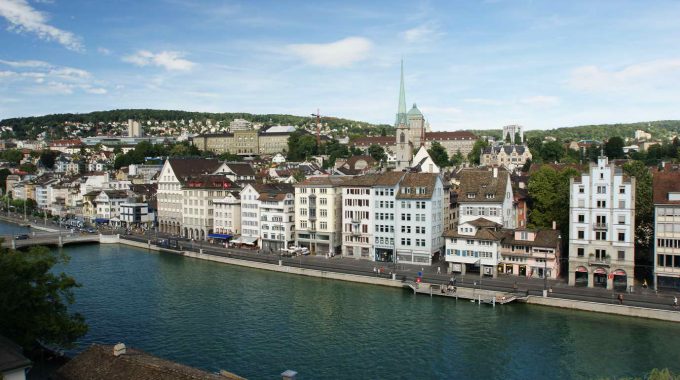
A European Journey #45 – Zürich (Switzerland)
When we talk about the city of Zürich and the Swiss Reformation, many think of the so-called ‘Affair of the Sausages’ when a group of citizens distributed and ate sausages publicly during the Lenten fast, and thus defied the Roman Catholic Church.
Yet this event, which occurred in 1522, was just one part of a Reformation that had already begun some years earlier.
So for this last stage of our miniseries following the footsteps of Huldrych Zwingli, we will visit Zürich. It is the most populous city of Switzerland and in 2012, it was ranked as the world’s most expensive city. The city is located at the north end of Lake Zürich where it flows into the Limmat River after the Quay Bridge (Quaibrücke). The canton of Zürich is a central location in Switzerland as it is surrounded by six cantons.
Half a kilometer further along the right bank of the Limmat river, we discover the most famous sight of Zürich as well as of the Swiss Reformation, the Romanesque cathedral Grossmünster. Before the sixteenth century, this place was a monastery, while the Fraumünster, located just on the other side of the river, was a convent.
Above the entry door of the Grossmünster, we read the following words: “In this House of God, Huldrych Zwingli’s Reformation took its start.”
From the times of Charlemagne, the Grossmünster had been a cathedral school. And in 1518, the preacher’s office was vacant. Oswald Myconius, Zwingli’s closest friend who was then schoolmaster in Zürich, knew this role would be perfect for his friend who was then still in Einsiedeln. Since Zwingli had already gained a positive reputation all across Switzerland, his appointment in this central location could have a huge impact across the country.
So it was that Myconius submitted the proposal to the church authorities of the city. And despite some opposition, Zwingli was finally elected preacher of Grossmünster on the 11th of December 1518. The news spread like wildfire and even reached Paris causing many Swiss students to rejoice.
Zwingli called his old friend from Basel, Leo Jud to replace him in Einsiedeln, and arrived in Zürich at the end of December. His first meeting with the church authorities already set the tone for his ministry. They wanted him to make sure that all citizens would pay their tithes. This greatly displeased Zwingli who answered that he was there to teach the Gospel. He said: “It is no new method. It is the old one. Recollect St Chrysostom’s homilies upon Matthew, and St. Augustine’s upon John.”
Restoring the preaching of the Word of God! This was exactly what had been lost at the time. So he preached his first sermon on the 1stof January 1519, in which he said: “It is to Christ that I wish to guide you, to Christ, the true spring of salvation. This divine word is the only food that I seek to minister to your hearts and souls”. This is the day that is considered to be the official start of the Reformation in Switzerland.
The time was ripe for a Reformation. Immorality had become the norm in the European Church. According to the Italian field marshal Aeneas Sylvius of Caprara, “licentiousness had become almost everywhere allowed”.
Many citizens came to listen to Zwingli in Grossmünster. Many heard the Gospel preached to them for the first time. And we can measure the rapid influence he had in Zürich. Only a month later, Samson, the seller of indulgences that we met in a previous episode, came to the city, only to be prohibited from selling them and banished the next day.
As we can imagine, Zwingli’s life was not without its challenges. He nearly died during the bubonic plague that swept through Northern Switzerland some months later. But finally, this plague drew more people to God.
The year 1522 saw the most famous event of the Swiss Reformation: the public distribution of smoked sausages during Lent. Many believe that this was a fruit of Zwingli’s ministry which emphasized the Word of God rather the rules of the Church. The main instigator, Christoph Froschauer, was arrested by the authorities only to be released shortly after through the influence of Zwingli.
After a public debate in 1523, the city council adopted Zwingli’s plans for reformation and thus became the first Swiss city to do so. Soon, St.Gallen, Schaffhausen, Basel, Bienne, Mulhouse and Bern followed.
Sadly, there is also a dark side to Zwingli’s story. It is related to the persecution of the Anabaptists. In a time when only one theology was tolerated, those who didn’t conform to it were seen as threats to the cohesion of the state, and thus were persecuted for their beliefs. This is what happened with the Anabaptists here in Zürich. Their rejection of infant baptism caused them to be drowned in the river by the Protestant authorities.
Zwingli died on the 11th of October 1531 on the battlefield of Kappel, during a war between the state of Zürich and an alliance of five Swiss states (or cantons) not yet reformed.
Huldrych Zwingli, a man coming from an unknown mountain village, was the unlikely figure who triggered the Swiss Reformation. Later, Genevan historian Jean-Henri Merle d’Aubigné described the man of Wildhaus “the focus of illumination for the whole Switzerland”.
See you next week somewhere else in Europe.
Cédric Placentino
Schuman Centre convener for Italian and French Europe
Follow A European Journey here.
Picture: Public Domain

This Post Has 0 Comments